pzgr40
Well-Known Member
Cutaway model of a 105 mm HESH Dm 512 cartridge (USA designation ‘Cartridge 105mm HEP-T M39A2’). This cartridge was fired by the 105mm L7A gun designed in England by Royal Ordnance, used in many tanks, including the Leopard 1 tank used by the cavalery of the Dutch army.
The term HESH stands for High Explosive Squash Head, in the USA this type of projectile is referred to as HEP (High Explosive Plastic).
The history of the HESH grenade goes back to the Second World War when the British Royal engineers were looking for an effective weapon to combat bunkers. Under the leadership of Denniston Burney, a projectile was designed with plastic explosives that formed to the shape of the target upon impact before exploding, and it was discovered that this was surprisingly effective against bunkers, but also against steel plates. However, it was not until 1947 that the Royal Engineers were given the Churchill VII tank, which used a low velocity 165mm shell from the short barreled L9A1 gun to fire HESH shells. After this, the use of HESH shells took off, especially in England, and until after the first Gulf War the HESH shell was the standard anti-tank shell in English tanks, also because the shell could be used as anti-structure and as an anti-personnel shell.
The HESH projectile works on the principle of transmitting chemical energy to the target; the projectile body of the HESH grenade is made of thin steel that easily deforms upon impact with the target. The explosive charge in the grenade is plasticized, so it is easily deformable. When the HESH grenade hits the target, the projectile body deforms in such a way that a kind of round slab of explosive is stuck to the armour, which is detonated with a delay of milliseconds - to allow the round slab to become large enough. The shock wave that is generated moves through the armour plate and will meet air on the other side of the plate. This causes the shock wave to reflect, creating an area in the armour plate with a double, crossing shock wave. The force that is generated here in the steel is so great that chunks of steel break off on the inside of the tank and are shot through the tank at supersonic speeds. This is called 'spalling' or 'spall'. This spall consists of hot steel that disables the crew and sets fuel or ammunition on fire.
In this you tube movie one can observe the effect of a HESH shell on the outside and the indide of a tank:
The disadvantage of the HESH projectile is that it only works on so-called single armor, i.e. a single thick steel plate; when 'spaced armor' is used, i.e. a double armor plate with an air space in between, composite armor (chobham armor) or active armor, the HESH projectile no longer works because the shock wave is disrupted and can no longer be effectively transmitted. Armor that is at an angle will also greatly reduce the effectiveness of the HESH projectile. That is why the HESH projectile is hardly used against tanks today and has been replaced by shaped charge (HEAT) projectiles and APFSDS-T projectiles that remain effective on the more modern forms of tank armor.
An advantage of the HESH projectile is that the velocity does not have to be excessively high, but only high enough flatten on the target, so that one can use guns with a short barrel and a low muzzle velocity, which makes the projectile suitable for use in the guns of light tanks, armoured vehicles and recoilless guns. In the guns of heavy tanks, reduced powder charges are used to keep the velocity lower.
The HESH shell is still used in some countries (England, USA) by the engineers, who use the projectile to destroy field fortifications and bunkers, since HESH works very well on concrete.
The 105mm DM 512 HESH cartridge described in this posting consists of a one-piece thin steel projectile body DM1064 on which two copper driving bands are attached at the lower portion. The aluminium base cap DM4 is screwed into the bottom of the projectile body with left-hand thread. The tracer element DM31 (also left-hand thread), referred to in the USA as ‘Tracer M12’, is screwed into the base of the aluminium base cap. The base fuze DM751 (right-hand thread), referred to in the USA as the ‘Fuze BD M578’, is screwed into the top of the aluminium base cap. The projectile body is filled with RDX, which is plasticized due to the addition of a few percent of wax. An inert layer of synthetic resin (black) is cast into the nose of the projectile body, which ensures that the force of the impact and the heat generated do not ignite the detonation prematurely.
Description and operation of the base fuze DM751 (USA designation; fuze BD M587);
(Photos 04, 05 and 06)
The fuze (photo 04) consists of a steel fuze body to which a booster charge is screwed into the top. The booster charge is closed at the top with a steel screw cap. A threaded ring is fitted around the outside of the booster, which serves to fix the booster against loosening.
Under the booster the safety and arming unit (photo 05) is placed, which ensures that the projectile only fully arms after the projectile has left the barrel for a few metres. A tray (1) houses the rotor (2) which houses a lead weight (3) and the duplex detonator (4), which is out of line with the firing pin in the central line of the fuze body. When safe, the firing pin cannot reach the duplex detonator. To the underside of the rotor is a tooth rack (5) bolted which is connected to a gear wheel which in turn is connected to an escapement. Into the side of the rotor is the spring-loaded centrifugal safety (6) is placed, also fixating a slider (7).
When the shot is fired, the rotation of the projectile throws the centrifugal safety (6) outwards riding the spring, releasing the rotor. Because the lead weight (3) of the rotor is out of alignment (the heaviest part is not on the outside), the centrifugal force will start to rotate the rotor (2) around its axis until the lead weight is on the outer circumference, only to be slowed down by the escapement which slows down the rotation by releasing only one tooth at a time. When the rotor has rotated to its maximum and the duplex detonator (4) is aligned with the firing pin, the slider (7) will be thrown outwards into a recess in the tray (1), fixating the rotor in the armed position.
The transport safety (photo 06) is placed below the safety and arming unit, consisting of an aluminium housing (8) in which two mirrored scissoring aluminium plates (9) are placed, both of which are held in the inner position by a spring around their axis (10), thus preventing the firing pin from moving forward. After the projectile has been fired, the two scissoring plates (9) are thrown outwards by the centrifugal force, allowing the firing pin to move forward upon impact. The firing pin is placed in the bottom of the same housing, held in the rear position by a spring.
A steel ball is placed under the firing pin (photo 04) in a hardened steel tube. This hardened steel tube prevents the ball from ‘eroding’ the inner wall of the fuze body due to the rotation after the projectile has been fired. Upon impact, the steel ball is swung forward by inertia, pushing the firing pin forward into the duplex detonator, which is ignited, after which the booster charge ignites, which ignites the main charge of the projectile.
The brass case DM 5 (USA designation; Case cartridge 105mm M150) is 617mm long. In the base is a threaded hole that houses the electrically ignited DM62 primer (picture 07). A perforated and powder filled pipe (the magazine) is screwed into the top of the electric primer, meant to ignite the main charge in the shellcase.
The main charge in the shellcase consists of a flat bag of powder folded into a triangle and placed around the electric primer and the magazine. A sheet of lead foil is glued to the inside of the powder bag, which decoppers the rifling of the barrel.
With new shells, the case is rolled over half of the upper driving band and over the full contour of the lower guide band. Since I do not have the right equipment to do this and I used a fired shellcase, this is missing here.
Vo projectile: 731 Mtr/sec
Maximum effective range: 3500 mtr
Total length of cartridge: 940 mm
Regards, DJH
The term HESH stands for High Explosive Squash Head, in the USA this type of projectile is referred to as HEP (High Explosive Plastic).
The history of the HESH grenade goes back to the Second World War when the British Royal engineers were looking for an effective weapon to combat bunkers. Under the leadership of Denniston Burney, a projectile was designed with plastic explosives that formed to the shape of the target upon impact before exploding, and it was discovered that this was surprisingly effective against bunkers, but also against steel plates. However, it was not until 1947 that the Royal Engineers were given the Churchill VII tank, which used a low velocity 165mm shell from the short barreled L9A1 gun to fire HESH shells. After this, the use of HESH shells took off, especially in England, and until after the first Gulf War the HESH shell was the standard anti-tank shell in English tanks, also because the shell could be used as anti-structure and as an anti-personnel shell.
The HESH projectile works on the principle of transmitting chemical energy to the target; the projectile body of the HESH grenade is made of thin steel that easily deforms upon impact with the target. The explosive charge in the grenade is plasticized, so it is easily deformable. When the HESH grenade hits the target, the projectile body deforms in such a way that a kind of round slab of explosive is stuck to the armour, which is detonated with a delay of milliseconds - to allow the round slab to become large enough. The shock wave that is generated moves through the armour plate and will meet air on the other side of the plate. This causes the shock wave to reflect, creating an area in the armour plate with a double, crossing shock wave. The force that is generated here in the steel is so great that chunks of steel break off on the inside of the tank and are shot through the tank at supersonic speeds. This is called 'spalling' or 'spall'. This spall consists of hot steel that disables the crew and sets fuel or ammunition on fire.
In this you tube movie one can observe the effect of a HESH shell on the outside and the indide of a tank:
The disadvantage of the HESH projectile is that it only works on so-called single armor, i.e. a single thick steel plate; when 'spaced armor' is used, i.e. a double armor plate with an air space in between, composite armor (chobham armor) or active armor, the HESH projectile no longer works because the shock wave is disrupted and can no longer be effectively transmitted. Armor that is at an angle will also greatly reduce the effectiveness of the HESH projectile. That is why the HESH projectile is hardly used against tanks today and has been replaced by shaped charge (HEAT) projectiles and APFSDS-T projectiles that remain effective on the more modern forms of tank armor.
An advantage of the HESH projectile is that the velocity does not have to be excessively high, but only high enough flatten on the target, so that one can use guns with a short barrel and a low muzzle velocity, which makes the projectile suitable for use in the guns of light tanks, armoured vehicles and recoilless guns. In the guns of heavy tanks, reduced powder charges are used to keep the velocity lower.
The HESH shell is still used in some countries (England, USA) by the engineers, who use the projectile to destroy field fortifications and bunkers, since HESH works very well on concrete.
The 105mm DM 512 HESH cartridge described in this posting consists of a one-piece thin steel projectile body DM1064 on which two copper driving bands are attached at the lower portion. The aluminium base cap DM4 is screwed into the bottom of the projectile body with left-hand thread. The tracer element DM31 (also left-hand thread), referred to in the USA as ‘Tracer M12’, is screwed into the base of the aluminium base cap. The base fuze DM751 (right-hand thread), referred to in the USA as the ‘Fuze BD M578’, is screwed into the top of the aluminium base cap. The projectile body is filled with RDX, which is plasticized due to the addition of a few percent of wax. An inert layer of synthetic resin (black) is cast into the nose of the projectile body, which ensures that the force of the impact and the heat generated do not ignite the detonation prematurely.
Description and operation of the base fuze DM751 (USA designation; fuze BD M587);
(Photos 04, 05 and 06)
The fuze (photo 04) consists of a steel fuze body to which a booster charge is screwed into the top. The booster charge is closed at the top with a steel screw cap. A threaded ring is fitted around the outside of the booster, which serves to fix the booster against loosening.
Under the booster the safety and arming unit (photo 05) is placed, which ensures that the projectile only fully arms after the projectile has left the barrel for a few metres. A tray (1) houses the rotor (2) which houses a lead weight (3) and the duplex detonator (4), which is out of line with the firing pin in the central line of the fuze body. When safe, the firing pin cannot reach the duplex detonator. To the underside of the rotor is a tooth rack (5) bolted which is connected to a gear wheel which in turn is connected to an escapement. Into the side of the rotor is the spring-loaded centrifugal safety (6) is placed, also fixating a slider (7).
When the shot is fired, the rotation of the projectile throws the centrifugal safety (6) outwards riding the spring, releasing the rotor. Because the lead weight (3) of the rotor is out of alignment (the heaviest part is not on the outside), the centrifugal force will start to rotate the rotor (2) around its axis until the lead weight is on the outer circumference, only to be slowed down by the escapement which slows down the rotation by releasing only one tooth at a time. When the rotor has rotated to its maximum and the duplex detonator (4) is aligned with the firing pin, the slider (7) will be thrown outwards into a recess in the tray (1), fixating the rotor in the armed position.
The transport safety (photo 06) is placed below the safety and arming unit, consisting of an aluminium housing (8) in which two mirrored scissoring aluminium plates (9) are placed, both of which are held in the inner position by a spring around their axis (10), thus preventing the firing pin from moving forward. After the projectile has been fired, the two scissoring plates (9) are thrown outwards by the centrifugal force, allowing the firing pin to move forward upon impact. The firing pin is placed in the bottom of the same housing, held in the rear position by a spring.
A steel ball is placed under the firing pin (photo 04) in a hardened steel tube. This hardened steel tube prevents the ball from ‘eroding’ the inner wall of the fuze body due to the rotation after the projectile has been fired. Upon impact, the steel ball is swung forward by inertia, pushing the firing pin forward into the duplex detonator, which is ignited, after which the booster charge ignites, which ignites the main charge of the projectile.
The brass case DM 5 (USA designation; Case cartridge 105mm M150) is 617mm long. In the base is a threaded hole that houses the electrically ignited DM62 primer (picture 07). A perforated and powder filled pipe (the magazine) is screwed into the top of the electric primer, meant to ignite the main charge in the shellcase.
The main charge in the shellcase consists of a flat bag of powder folded into a triangle and placed around the electric primer and the magazine. A sheet of lead foil is glued to the inside of the powder bag, which decoppers the rifling of the barrel.
With new shells, the case is rolled over half of the upper driving band and over the full contour of the lower guide band. Since I do not have the right equipment to do this and I used a fired shellcase, this is missing here.
Vo projectile: 731 Mtr/sec
Maximum effective range: 3500 mtr
Total length of cartridge: 940 mm
Regards, DJH
Attachments
-
 01 - 105 x 617 DM 512 HESH-T cutaway.jpg543.4 KB · Views: 50
01 - 105 x 617 DM 512 HESH-T cutaway.jpg543.4 KB · Views: 50 -
 02 - 105 x 617 DM 512 HESH-T backside.jpg449.9 KB · Views: 49
02 - 105 x 617 DM 512 HESH-T backside.jpg449.9 KB · Views: 49 -
 03 - 105 x 617 DM 512 HESH-T projectile cutaway.jpg666.3 KB · Views: 39
03 - 105 x 617 DM 512 HESH-T projectile cutaway.jpg666.3 KB · Views: 39 -
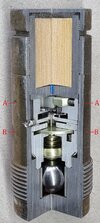 04- cutawayFuze BD M578 cutaway.jpg610.2 KB · Views: 42
04- cutawayFuze BD M578 cutaway.jpg610.2 KB · Views: 42 -
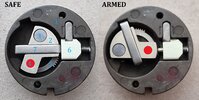 05- cutawayFuze BD M578 section A-A.jpg655.9 KB · Views: 39
05- cutawayFuze BD M578 section A-A.jpg655.9 KB · Views: 39 -
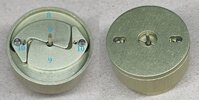 06- cutawayFuze BD M578 section B-B.jpg671.2 KB · Views: 36
06- cutawayFuze BD M578 section B-B.jpg671.2 KB · Views: 36 -
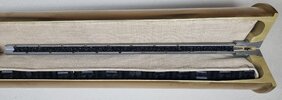 07 - Electric primer with magazine DM62 for shellcase 105 x 617 DM 512.jpg664.4 KB · Views: 38
07 - Electric primer with magazine DM62 for shellcase 105 x 617 DM 512.jpg664.4 KB · Views: 38 -
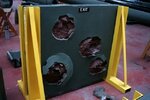 08- effect HESH shell on inside of tank.jpg76 KB · Views: 50
08- effect HESH shell on inside of tank.jpg76 KB · Views: 50
Last edited:
